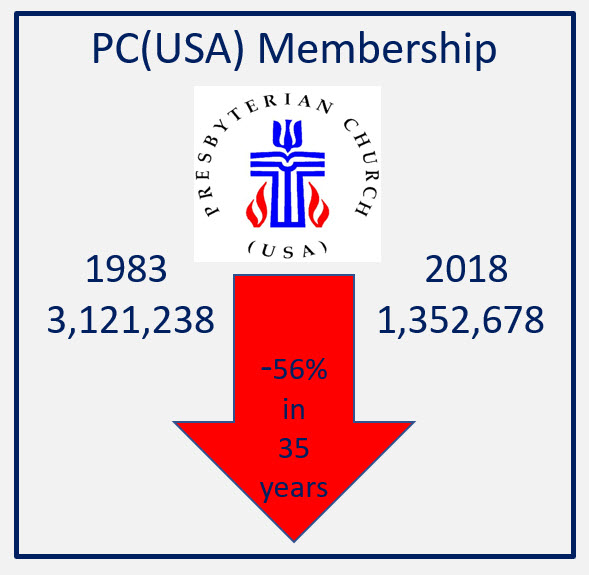The Presbyterian Church (USA) was created by a merger of the United Presbyterian Church in the U.S.A. and the Presbyterian Church in the United States in June 1983. The newly formed denomination started with a membership of 3,131,228.
Membership Decline
The denomination has experienced year-over-year membership decline every year since it began.
Over the last three decades, the rate of decline has increased:
- 1988-1998 – 11.9%
- 1998-2008 – 17.3%
- 2008-2018 – 36.8%
In the denomination’s first 35 years membership declined by 56.8% from
3,131,228 to 1,352,678.

Congregational Size
These 1.35 million members are distributed across 9,270 congregations.
For the most recent year, the PCUSA reported the following data for number of congregations in each membership category:
- 1-100 members: 5,546
- 101-200 members: 1,886
- 201-300 members: 735
- 301-500 members: 584
- 501-800 members: 296
- 801-1200 members: 121
- 1201-1500 members: 52
- 1601 or or more members: 50
By combining these groups to create small, medium, and large congregations, it becomes apparent that 4 out of 5 congregations are quite small:
- 1-200 members: 80.2% of congregations
- 201-800 members: 17.4% of congregations
- 801 or more members: 2.4% of congregations
So What?
The Presbyterian Church (USA) is not alone. American Mainline Protestant decline was well underway by the time the denomination came into being.
This denomination has been a part of my life longer than any other. I’ve invested myself significantly into four PCUSA congregations:
- First Presbyterian Church (Arlington, TX) – actively participated from birth until starting college
- First Presbyterian Church (Duncanville, TX) – served this congregation while completing my seminary studies
- First Presbyterian Church (Naples, FL) – served this congregation from 2007-2010
- First Presbyterian Church (Fort Worth, TX) – actively involved as a member since 2019
To better understand this decline in its larger context, consider reading “UCC Decline Enters 7th Decade.“